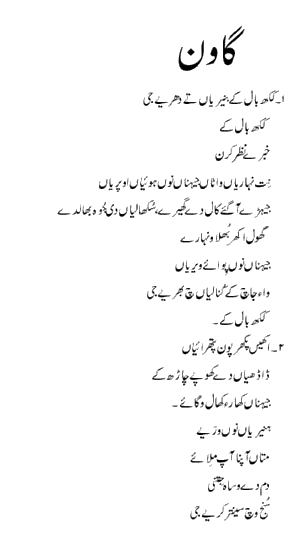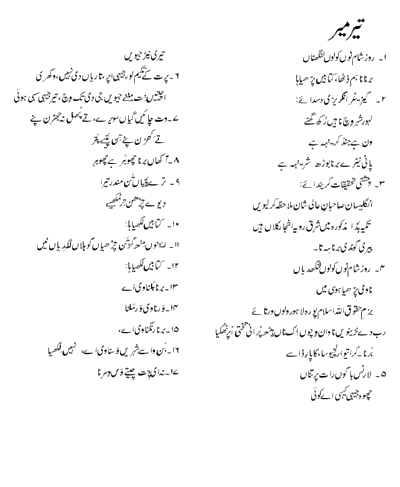Elegies of nature and mother tongue
by: Nadir Ali
The NEWS - Sunday, November 30, 2003
All of Najam Hussain Syed's poetic work has been written in rhythm and rhyme, meant to be sung or dramatically recited like most classical Punjabi poetry
I consider Najam Hussain Syed's writings on literary criticism to be his greatest contribution to Punjabi literature though his literary work, comprising 22 books, covers other subjects like poetry and drama as well.
But I am writing this article on his poetry rather than on his critical writings. This may be because poetry is usually thought to be more representative and personal of a writer's work. Even in its transcendental and universalised forms, poetry remains a deeply personal expression.
To discuss Najam Hussain Syed's poetry, I have selected two of his recent poems, rather than reviewing his books or analysing his collective poetic creation. By choosing to criticising an entire body of a literary creation, we tend to generalise which is the bane of criticism and is no help in understanding the work of a poet like Najam Hussain Syed. I intend to present his work with translations and as little comment as possible.
Najam is generally criticised for being partial to Lehndi (western Punjab)  and Seraiki (Southern Punjab) dialect. But the two poems under review here uses Maji, the central Punjab dialect, as well as the Lehndi/Seraiki one which is, perhaps, the more pristine of the Punjabi dialects.
and Seraiki (Southern Punjab) dialect. But the two poems under review here uses Maji, the central Punjab dialect, as well as the Lehndi/Seraiki one which is, perhaps, the more pristine of the Punjabi dialects.
Like all the masters of Punjabi letters -- Baba Farid, Guru Nanak, Shah Hussain, Waris Shah, Sultan Bahu, Bulleh Shah -- he has used all the dialects of Punjabi in his different compositions. The constraint of space prevents me from including one of his poems written in Potohari, the northern Punjab dialect.
1-Let's light up some straws
and put these on rooftops
to show the way
May be they look back,
Those to whom the oft walked
ways became alien,
Those who got trapped by
Time,
While reconnoitering the
hostile territory of the leisured classes,
Those to whom adversaries
administered
a potion of obfuscating words,
Let us put some straws in earthen trays and place these, keeping the wind in view
Let us light some straws and put these on rooftops -- to
show the way
2-May the stone frozen eyes
melt
of those wore the adversaries' blindfolds
And ploughed the saline
streams.
Let us wed the darkness.
May be we will thus
rediscover ourselves.
Let us send a signal into the
wilderness.
The signal of a light breath of
hope!
Let us light up some straws and put these on rooftops
-- to show the way
It is difficult, if not impossible to translate a song written in rhythm and rhyme and using subtle nuances of language. I have attempted a literal translation except in parenthesis that say 'to show the way'. In Punjabi, to light up something and put it on a rooftop implies showing the way. In the next poem, only one word is added in translation in the second line, to make it rhyme with the preceding one as well as to indicate the emphasis implied in Punjabi.
Roughly and very arbitrarily, Najm's poetry can be be divided into four periods; early poetry, poetry of resistance and revolution, poetry of irony after the failure of revolution, and poetry of reappraisal and resolution.
Beginning with the earliest period, all of Najm's poetry has been written in rhythm and rhyme, using meters of folk songs and ragas. It is meant to be sung or dramatically recited, like most classical Punjabi poetry.
The poem roughly belongs to the period of post revolutionary irony. It exhibits hoping against hope. Lighting up straws is a very fragile and vulnerable device. Poetry itself is a very fragile craft. It is like "lighting up some straws". While a song may move mountains, its strength lies in its lightness. Moreover, the poet is singing to those who are stone frozen, hardened and brutalised by the oppression of the market and suppression by the upper class. Only a light, loving touch can heal the victims of such a brutality. The victims have been trapped by Time (Kaal) at a juncture of history where people have lost yet another battle. They were lured and dazzled by the forces of the market. The poet instead chooses to "wed the darkness". Only by turning away from the dazzle of the market, he seems to say, we may hope to recover and re-discover ourselves.
This poem, like the next poem under review, is also an elegy to the mother tongue. The symbols and signposts are linguistic and cultural. After all, language evolved from history and is an apt metaphor for history.
Thine and Mine
1-I pass by it everyday -- but -- I had not seen the Barna 
tree,
in books I had read the entry.
2-The English Gazetteer says,
"Lahore city does not have
many trees;
Wan, Jand and Kareenh, one
sees and near water, the Borh,
Barna and Shareenh."
3-Chishti researches -- in
"Tehkikat-e-Chishti"
"the English Sahibs, of glory
great,
may for themselves see the
state; the above mentioned tomb shows
large trees on the eastern side;
the threesome Goondny,
Bery and Barna."
4-I pass by it everyday;
may have read the name too,
under one of the ninety-nine names of God,
distributed by Association for Rights of God, Islampura Lahore,
is nailed an old sign board,
"Barna krateva religiosa
capparidaceaea".
5-I return at night from Lawrence Gardens;
What is this agitation I feel,
Like your nearness!
6-I look back and see a kind of
light, no not like the stars, but
different;
as if in someone that I meet
everyday,
I suddenly see the other.
7-In excitement next morning I
go;
There are flowers falling. Lo!
And three petal leaves burst
forth.
8-Is Barna a boy or a girl?
The two girls on the side,
huddling, the third one in
between!
9-The three leafs are the temple
of your body
-- open armed!
the three -- flame oil lamps,
lit up in offering!
10-It is written in the books,
"It has sweet berries with a
bitter tinge".
11-In the books it is written,
"The Barna wood burns -- oh
this fire catcher!
It weds too; this bride snatcher!
It is also used for coloring".
12-That it lives in exile, no one
wrote,
Nor no one wrote, of the loss of
memory and will!
This poem is one of Najam Hussain Syed's latest and proves the futility of categorisation of his poetry into periods, for instance.
Trees and seasons have been a frequent metaphor in Najam's poetry. The seasons symbolise history and potential for change. Trees have also been used as a symbol of something alive but downgraded in this case for being native.
The poem highlights the irony of class and we see a class conscious attitude even towards nature. The poplars and eucalyptus trees, despite their relatively useless wood and scant shade, are not looked down upon as are the Keekar and Shisham for being native. You cannot imagine having a Keekar tree in your million dollar mansion.
But the poet develops an autonomous aesthetic of his own to see beauty in native trees, that become a symbol for the down trodden. The distortion of our aesthetics is the central theme in most of Najm's poetry and the key to his unique sensibility.
The poem has a multi-layered symbolism. It starts on a prosaic post modern note. We see colonial contempt for the natives and the post colonial devastation of the native mind and culture. Why hasn't the poet seen the Barna tree, that was literally planted in the heart of every Punjabi village and would endure for centuries? Is it due to the exile suffered in the city, the seat of colonial power. Or, is it the self-inflicted blindness of the Ziaist mullahism?
Man, God's supreme creation, was bowed to by all angels because he knew the 'names'. Now the Barna tree and its name have been crucified in the name of God. The self-serving and self-advertising Bazm-e-Huquq Allah Islampura, has taken over our prayers and contemplation. The apparent and false duality seen in the Me-Thou relationship between man and God turns into a Mine-Thine relationship of property and of the ruler and the ruled. The forgotten Barna tree becomes the other but its rediscovery in the poet's imagination finally effects unity.
The poem, like a string tuned and taut, plays many tunes. Even the botanical name of the tree is evocative of the Latin prayer. The poem is about the loss of heritage and with it the language of the people, a recurrent theme in Najm's poetry. In its second part, the poet breaks into a song. Lyrical and rhapsodic, he talks of light, fire, colour and wedding. The awkward and clownish first part, till line five, contrasts sharply with the spontaneity and music of the second part.
But there is more than one division in the poem. The poet, after breaking into song, turns bookish. The poet then carries the reader through light, fire worship and physical love, to rediscovery. The transformation is effected through rediscovery of the poet's sight and language. We not only not see the trees that we pass by every day, we also don't see the people around us. In the end, the effect shifts from poetic to dramatic. The poet seems to suggest this is no time to sing.